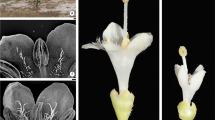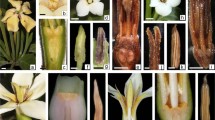Abstract
The tribe Paullinieae is distinguished by a monoecious reproductive system; it exhibits two floral morphs, namely staminate flowers, with gynoecium reduced to a pistillode, and morphologically hermaphrodite but functionally pistillate flowers. The aim of this study was to analyze the development of sporogenesis and gametogenesis in flowers of Thinouia mucronata Radlk. (subtribe Thinouiinae) and Serjania meridionalis Cambess. (subtribe Paulliniinae) and to elucidate the moment when pollen grains of pistillate flowers and the ovule of staminate ones stopped their development. Light and scanning electron microscopy was applied using standard techniques. In T. mucronata flowers are actinomorphic; the pistillate ones have anatropous, pseudocrassinucellate ovules, without hypostase and with placental obturator, and stamens with indehiscent anthers and well-developed pollen grains that remain inside the pollen sac at the end of anthesis. Serjania meridionalis has zygomorphic flowers, the pistillate ones have campylotropous, crassinucellate ovules, with presence of hypostase, and funicular obturator, and stamens with indehiscent anthers collapsed at the end of anthesis, showing remnants of aborted sporogenous tissue in each pollen sac. Both species share the anatomy of the anther wall; microsporocytes form tetrahedral or decussate tetrads; monads are bicellular; the pistillode has abortive megaspore; gynoecium with bithegmic ovules and Polygonum-type megagametophyte. One difference in antheral wall ontogeny between species was that T. mucronata displayed the dicotyledoneus type development, whereas S. meridionalis exhibited the basic type. These embryological characters clearly support the basal position of Thinouia in the tribe recently validated from molecular phylogeny studies and supported by the present morphological data.






Similar content being viewed by others
References
Acevedo-Rodríguez P (2003) Melicocceae (Sapindaceae): Melicoccus and Talisia. In: Flora Neotropica Monograph 87:1–179. (New York Botanical Garden: New York, NY, USA)
Acevedo-Rodríguez P, Van Welzen PC, Adema F, Van Der Ham RWJM (2011) Sapindaceae. In: Kubitzki K (ed) Flowering Plants, Eudicots: Sapindales, Cucurbitales, Myrtaceae. The Families and Genera of Vascular Plants. Springer, Berlin, pp 357–407
Acevedo-Rodríguez P, Wurdack KJ, Ferrucci MS, Johnson G, Pedro Dias P, Coelho RLG, Somner GV, Steinmann VW, Zimmer EA, Strong MT (2017) Generic relationships and classification of tribe Paullinieae (Sapindaceae) with a new concept of supertribe Paulliniodae. Syst Bot 42:96–114. https://doi.org/10.1600/036364417X694926
Avalos A, Zini M, Ferrucci MS, Lattar E (2019) Anther and gynoecium structure and development of male and female gametophytes of Koelreuteria elegans subsp. formosana (Sapindaceae). Flora 255:98–109. https://doi.org/10.1016/j.flora.2019.04.003
Bachelier JB, Endress PK (2009) Comparative floral morphology and anatomy of Anacardiaceae and Burseraceae (Sapindales), with a special focus on gynoecium structure and evolution. Bot J Linn Soc 159:499–571. https://doi.org/10.1111/j.1095-8339.2009.00959.x
Bawa KS (1977) The reproductive biology of Cupania guatemalensis Radlk. (Sapindaceae). Evol 31:52–63. https://doi.org/10.1111/j.1558-5646.1977.tb00981.x
Budar F, Pelletier G (2001) Male sterility in plants: occurrence, determinism, significance and use. Compt Rendus Acad Sci III Sci Vie 324:543–550. https://doi.org/10.1016/S0764-4469(01)01324-5
Buerki S, Forest F, Acevedo-Rodríguez P, Callmander MW, Nylander JAA, Harrington M, Sanmartín I, Küpfer P, Alvarez N (2009) Plastid and nuclear DNA markers reveal intricate relationships at subfamilial and tribal levels in the soapberry family (Sapindaceae). Mol Phylogenet Evol 51:238–258. https://doi.org/10.1016/j.ympev.2009.01.012
Cao LM, Xia NH, Deng YF (2008) Embryology of Handeliodendron bodinieri (Sapindaceae) and its systematic value: development of male and female gametophytes. Plant Syst Evol 274:17–23. https://doi.org/10.1007/s00606-008-0024-0
Cao LM, Xia NH (2009) Floral organogenesis of Delavaya toxocarpa (Sapindaceae; Sapindales). J Syst Evol 47:237–244. https://doi.org/10.1111/j.1759-6831.2009.00023.x
Cole TCH, Ferrucci MS (2020) Sapindaceae Phylogeny Poster. https://doi.org/10.13140/RG.2.2.11526.29767
Corner EJH (1976) The seeds of dicotyledons. Cambridge University Press, Cambridge
Davis GL (1966) Systematic embryology of the angiosperms. Wiley, New York
de Lima HA, Somner GV, Giulietti AM (2016) Duodichogamy and sex lability in Sapindaceae: the case of Paullinia weinmanniifolia. Plant Syst Evol 302:109–120. https://doi.org/10.1007/s00606-015-1247-5
Ferrucci MS (1991) Sapindaceae. In: Spichiger RS, Ramella L (eds) Flora del Paraguay 1–144
Ferrucci MS (2005) Sapindaceae. In: Castro Souza V, Lorenzi H (eds) Botậnica Sistemática. Nova Odessa: Instituto Plantarum de Estudos da Flora Ltda 437–441
Ferrucci MS, Anzótegui LM (1993) El polen de Paullinieae (Sapindaceae). Bonplandia 6:211–243
Gonzalez AM, Cristóbal CL (1997) Anatomía y ontogenia de semillas de Helicteres Lhotzkyana (Sterculiaceae). Bonplandia 9:287–294
González VV, Solís SM, Ferrucci MS (2014) Anatomía reproductiva en flores estaminadas y pistiladas de Allophylus edulis (Sapindaceae). Bol Soc Argent Bot 49:207–216
González VV, Solís SM, Ferrucci MS (2017) Embryological studies of Magonia pubescens (Dodonaeaeae, Sapindaceae): development of male and female gametophytes in both floral morphs and its phylogenetic implications. Aust Syst Bot 30:279–289. https://doi.org/10.1071/SB17021
Gulati N, Mathur S (1977) Embryology and taxonomy of Filicium decipiens. Phytomorphol 27:261–266
Ha CO, Sands VE, Soepadmo E, Jong K (1988) Reproductive patterns of selected understorey trees in the Malaysian rain forest: the sexual species. Bot J Linn Soc 97:295–316
Johansen DA (1940) Plant microtechnique. McGraw-Hill Book Company Inc, New York
Johri BM, Ambegaokar KB, Srivastava PS (1992) Comparative embryology of Angiosperms. Springer-Verlag, New York
Kadry A (1946) Embriology of Cardiospermum halicacabum L. Svensk Bot Tidskr 40:111–126
Karkare-Khushalani I, Mulay BN (1964) Studies in Sapindaceae. I Embryology of Dodonaea Viscosa Phyton (Horn) 11:83–92
Luque R, Sousa HC, Kraus JE (1996) Métodos de coloração de Roeser (1972) - modificado - E. Kropp (1972) visando a substituição do azul de astra por azul de alcião 8GS ou 8GX. Acta Bot Bras 10:199–212
Mathur S, Gulati N (1980) Embryology and taxonomy of Allophylus alnifolius Radlk. ex Engl. (Sapindaceae). Indian J Bot 3:103–112
Mathur S, Gulati N (1981) Embryology of Lepidopetalum jackianum Hiern. Indian J Bot 4:216–221
Mathur S, Gulati N (1989) Embryological studies in Allophylus zeylanicus L. Indian J Bot 12:62–65
Mayer SS, Charlesworth D (1991) Cryptic dioecy in flowering plants. Trends Ecol Evol 6:320–325. https://doi.org/10.1016/0169-5347(91)90039-Z
Mitchell CH, Diggle PK (2005) The evolution of unisexual flowers: morphological and functional convergence results from diverse developmental transitions. Am J Bot 92:1068–1076. https://doi.org/10.3732/ajb.92.7.1068
Nair NC, Joseph J (1960) Morphology and embryology of Cardiospermum halicacabum. J Indian Bot Soc 39:176–194
O’Brien TP, Cully ME (1981) The Study of Plant Structure. Principles and Selected Methods. Termarcarphi Pty., Melbourne
Payer JB (1857) Traité d’organogénie comparée de la fleur. Masson, Paris
Radlkofer L (1931–1934) Sapindaceae. In: Das Pflanzenreich (ed Engler, A). 98: pp 1539. (Wilhelm Engelmann: Leipzig, Germany)
Ronse Decraene LP, Smets E, Clinckemaillie D (2000) Floral ontogeny and anatomy in Koelreuteria with special emphasis on monosymmetry and septal cavities. Plant Syst Evol 223:91–107. https://doi.org/10.1007/BF00985329
Shamrov H (1998) Ovule classification in flowering plants-New approaches and concepts. Bot Jahrb Syst 120:377–407
Solís SM, Galati BG, Ferrucci MS (2010) Microsporogenesis and microgametogenesis of Cardiospermum grandiflorum and Urvillea chacoensis (Sapindaceae, Paullinieae). Aust J Bot 58:597–604. https://doi.org/10.1071/BT10162
Solís SM (2011) Estudios morfo-anatómicos y ontogenéticos en flores de Paullinieae (Sapindaceae) y su significado evolutivo. PhD thesis. Universidad Nacional de Córdoba, Argentina
Solís SM, Zini LM, González VV, Ferrucci MS (2017) Floral nectaries in Sapindaceae s.s.: morphological and structural diversity, and their systematic implications. Protoplasma 254:2169–2188. https://doi.org/10.1007/s00709-017-1108-x
Vary LB, Sakai AK, Weller SG (2011) Morphological and functional sex expression in the Malagasy endemic Tina striata (Sapindaceae). Am J Bot 98:1040–1048. https://doi.org/10.3732/ajb.1000479
Weckerle CS, Rutishauser R (2005) Gynoecium, fruit and seed structure of Paullinieae (Sapindaceae). Bot J Linn Soc 147:159–189. https://doi.org/10.1111/j.1095-8339.2005.00365.x
Yadav N, Pandey AK, Bhatnagar AK (2016) Cryptic monoecy and floral morph types in Acer oblongum (Sapindaceae): An endangered taxon. Flora 224:183–190. https://doi.org/10.1016/j.flora.2016.07.018
Yadav N, Pandey AK, Bhatnagar AK (2017) Comparative anther and pistil anatomy of three flowering morphs of andromonoecious Acer oblongum Wall. ex DC. (Sapindaceae s.l.) and its adaptive significance. Nord J Bot 36:1572. https://doi.org/10.1111/njb.01572
Ye XL, Wang FX, Qian NF (1992) Embryological studies of Litchi chinensis. Acta Bot Yunnan 14:59–65
Zini LM, Galati BG, Solís SM, Ferrucci MS (2012) Anther structure and pollen development in Melicoccus lepidopetalus (Sapindaceae): An evolutionary approach to dioecy in the family. Flora 207:712–720. https://doi.org/10.1016/j.flora.2012.07.003
Zhou QY, Liu GS (2012) The embryology of Xanthoceras and its phylogenetic implications. Plant Syst Evol 298:457–468. https://doi.org/10.1007/s00606-011-0558-4
Acknowledgements
Financial support for this research was provided by General Secretariat of Science and Technology, National University of the Northeast (PI N° 16 F022 and 20F013 ), the National Council of Scientific and Technological Research (PIP 11220170100429C), Argentina, and by a grant of the Myndel Botanica Foundation, for which we are profoundly grateful.
Author information
Authors and Affiliations
Contributions
SMS performed experiments work, analyzed data and prepared the figures. SMS and MSF wrote the article. MSF edited the final version of the manuscript. Both authors have approved the final manuscript.
Corresponding authors
Ethics declarations
Conflict of interest
The authors declare that there is no conflict of interest regarding the publication of this article.
Additional information
Publisher's Note
Springer Nature remains neutral with regard to jurisdictional claims in published maps and institutional affiliations.
Rights and permissions
About this article
Cite this article
Solís, S.M., Ferrucci, M.S. Embryological studies in Thinouia mucronata and Serjania meridionalis (Paullinieae, Sapindaceae): development of gametophytes in both floral morphs and its phylogenetic implications. Braz. J. Bot 45, 399–413 (2022). https://doi.org/10.1007/s40415-021-00730-y
Received:
Revised:
Accepted:
Published:
Issue Date:
DOI: https://doi.org/10.1007/s40415-021-00730-y




